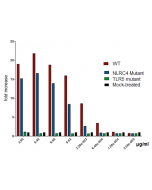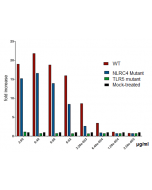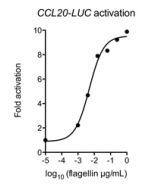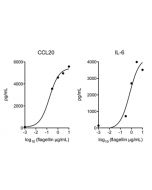Cookie Policy: This site uses cookies to improve your experience. You can find out more about our use of cookies in our Privacy Policy. By continuing to browse this site you agree to our use of cookies.
AdipoGen Life Sciences
anti-TLR5 (human), mAb (ABM22G1)

| Product Details | |
|---|---|
| Synonyms | Toll-like Receptor 5; Toll/interleukin-1 Receptor-like Protein 3; TIL3; MELIOS; SLE1; SLEB1 |
| Product Type | Monoclonal Antibody |
| Properties | |
| Clone | ABM22G1 |
| Isotype | Mouse IgG2aκ |
| Immunogen/Antigen | Recombinant human TLR5 protein (aa 261-420). |
| Application |
Immunohistochemistry: (10μg/ml; paraffin sections) |
| Crossreactivity | Human |
| Specificity |
Recognizes human TLR5. |
| Purity | Protein G purified. |
| Concentration | 0.5mg/ml |
| Formulation | Liquid. In PBS containing 0.05% BSA and 0.05% sodium azide. |
| Isotype Negative Control | |
| Accession Number | O60602 |
| Shipping and Handling | |
| Shipping | BLUE ICE |
| Short Term Storage | +4°C |
| Long Term Storage | -20°C |
| Handling Advice |
After opening, prepare aliquots and store at -20°C. Avoid freeze/thaw cycles. |
| Use/Stability |
Stable for at least 1 year after receipt when stored at -20°C. Stable for at least 6 months after receipt when stored at +4°C. |
| Documents | |
| MSDS |
 Download PDF Download PDF |
| Product Specification Sheet | |
| Datasheet |
 Download PDF Download PDF |
TLR5 (Toll-like Receptor 5) is a member of the Toll-like receptor (TLR) family which plays a fundamental role in pathogen recognition and activation of innate immunity. TLR5 recognizes bacterial flagellin, a principal component of bacterial flagella and a virulence factor, via a conserved region within flagellin, the D1 portion/domain. Binding of flagellin induces the dimerization of TLR5, which in turn recruits MyD88. The recruitment of MyD88 leads to subsequent activation of IRAK4, IRAK1, TRAF6 and eventually IκB kinases. Activation of IκB kinases mobilizes the nuclear factor NF-κB and stimulates many downstream gene expressions, which initiate the canonical proinflammatory pathway, including TNF-α production. TLR5 may play a role in inflammatory bowel disease (IBD). Lower levels of TLR5 expression have been found in patients exhibiting moderate to severe ulcerative colitis (UC). TLR5 is suggested to be possibly involved in HPV induced inflammation and subsequent cervical neoplasia formation. It has been reported that TLR5 expression is detected in both ovarian epithelium and ovarian cancer cell lines, suggesting a possible role of TLR5 in inflammation induced ovarian cancer onset. Mutations in this gene have been associated with both resistance and susceptibility to systemic lupus erythematosus and susceptibility to legionnaire disease, highlighting the importance of TLR5 in microbial recognition particularly at the mucosal surface.









